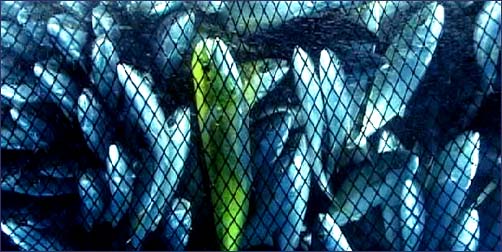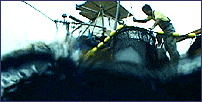
|
No.16 Dorado Fishing in the Sea of Genkai. |

|
No.16 Dorado Fishing in the Sea of Genkai. |

|
|
|
Fish caught by an extention of man's hand,the fishing net. |
|
|
The sea in the northwest part of Kyushu is famous for its abundant
fishing. This sea, also known as the western entrance to the Sea of
Japan, is also famous for its rough seas due to its shallow waters and
many reefs. The richness of this sea can be felt in the words and
phrases of the local fisherman. How does this sea, which 'keeps
spitting up more fish no matter how much you fish it', and has the
confidence of the fisherman, support so much life?
The long awaited opportunity for me to answer this question presented itself early this summer. I was asked to produce a TV program about marine creatures in the Sea of Genkai with RKB Mainichi Broadcasting System in Fukuoka. I immediately set out to study the material on the Sea of Genkai, and felt the shadow of the 'Tsushima' current and the Sea of Japan' and its influence. The following is not the opinon of a marine specialist and is only a personal opinion but I hope you will regard it as one line of reasoning. Tsushima current, a warm current, runs into the Sea of Japan across the Sea of Genkai from the southwest to the northeast where it enters the Sea of Japan. It enters the Sea of Japan along the Japanese coast and runs up the Noto Peninsula and the Sado Island, and reaches the western coast of Hokkaido. As the waters move north, the Tsushima current is slowly cooled and its water temperature comes down. In the past, it was thought that the Tsushima current continues its way north after reaching Hokkaido. Recent studies have clarified the following. Because the seabed between the Eurasian continent and Hokkaido is shallow, the current cannot continue upwards and turns around and becomes the Liman cold current. The cold current proceeds south along the coast of Russai and China. To put it simply, because the Sea of Japan's surrounding are shallow like a tray, the Tsushima current which comes from the south and enters the Sea of Japan, does not discharge from the narrow exit in the north, and turns around again and begins to go south. Moreover, because the water is cooled by the cold weather of the north and becomes heavier, the current makes its way south deeper along the seabed. The southerly Lima current changes direction when it reaches the Korean Peninsula and flows out into the shallows of the Sea of Genkai as an upwelling. This upswelling contains plenty of nutrient salts such as phosphorous and kalium etc. The plankton brought up by the Tsushima current photosynthesizes by using the nutrient salts and produces nutrients. These nutrients maintain the base of the food chain in the Sea of Genkai and breed the aubundant marine life. This is the inference of an arm chair oceanographer. I wanted to experience the richness of the Sea of Genkai and joined the 'Wakashio-maru', a fishing boat going Dorado fishing. The dorado is a noted fish of this sea. Dorado fishing begins from Kanegasaki, a fishing port about 30km northeast of Hakata at 3 o'clock in the morning. The return is dependent upon the catch. It was not at all, an easy fishing. Although it is called dorado fishing, the real objective is not dorado but baby yellowtail which is used for breeding 'hamachi' or young yellow tail. The fishing works like this. Ten or so 'mosochikus', thick stemmed bamboo, is bundled together. Many buoys are used to mark the spot. Sandbags are connected to the bamboo by ropes and used as under water weights to the Sea of Genkai's seabed, which is 50-70m below, which anchors the raft. Small fish that are attracted to the 'moschiku' bamboos floating likethe buoys, are caught using nets. It is fishing which takes advantage of the behavior of fish looking for something in the open sea and gathering around flowing algae like the sargasso. From port, it took more than six hours to reach the fishing spot. It was out in the open sea where you can see the Tsushima Island off in the distance. I decided to dive into the sea and observe the dorado fishing underwater. The sea was so calm that even Mr. Yashiro, the boat's captain, was surprised. A few hundred baby yellowtails which still had an innocent look about them, were swimming pell-mell in the net. The dorado which were caught by mistake made themselves turn yellow, and the baby yellowtails looked blue and pale to me. The fishermen collected the fish at one corner of the net being careful not to damage the bodies and brought the fish into the breeding pool. Visiting the more than 80 rafts meant the fishing continued without end. It was a great catch that day.  Men learn from the morning sun, the night moon, the birds and whales.
The lesson learned from the flowing algae gives us a plentiful supply of
fish as long as man does not corrupt nature's balance. Men learn from the morning sun, the night moon, the birds and whales.
The lesson learned from the flowing algae gives us a plentiful supply of
fish as long as man does not corrupt nature's balance.
|
|
So as not to damage the bodies, the fishermen carefully scoop up the fish and move them into the breeding pool. |
|
|